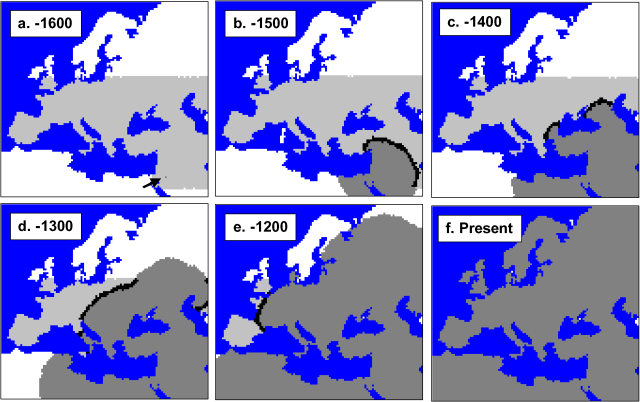 |
This is a file from the Wikimedia Commons. Information from its description page there is shown below.
Commons is a freely licensed media file repository. You can help.
|
 |
This map image could be recreated using vector graphics as an SVG file. This has several advantages; see Commons:Media for cleanup for more information. If an SVG form of this image is already available, please upload it. After uploading an SVG, replace this template with {{ vector version available|new image name.svg}}. |
Summary
| Description |
Range Expansion of Modern Humans into Europe from the Near East. Simulations begin 1,600 generations ago, with the area of Europe already colonized by Neanderthals shown in light gray, and an origin of modern human expansion indicated by a black arrow (Diagram A). Diagram (B–F) show the progression of the wave of advance of modern humans (dark gray) into Europe at different times before present. The black band at the front of the expansion wave represents the restricted zone of cohabitation between modern humans and Neanderthals. |
| Date |
19 October 2006 |
| Source |
http://dx.doi.org/10.1371/journal.pbio.0020421.g002 |
| Author |
Mathias Currat, Laurent Excoffier |
Licensing

 |
This file is licensed under the Creative Commons Attribution 2.5 Generic license. |
|
|
|
- You are free:
- to share – to copy, distribute and transmit the work
- to remix – to adapt the work
- Under the following conditions:
- attribution – You must attribute the work in the manner specified by the author or licensor (but not in any way that suggests that they endorse you or your use of the work).
http://creativecommons.org/licenses/by/2.5 CC-BY-2.5 Creative Commons Attribution 2.5 truetrue
|
|
This file was published in a Public Library of Science journal. Their website states that the content of all PLOS journals is published under the Creative Commons Attribution 2.5 license, unless indicated otherwise.
|
File usage
The following pages on Schools Wikipedia link to this image (list may be incomplete):
Wikipedia for Schools is one of SOS Children's Villages' many educational projects. The world's largest orphan charity, SOS Children brings a better life to more than 2 million people in 133 countries around the globe. Want to learn more? Go to http://www.soschildrensvillages.org.uk/sponsor-a-child



